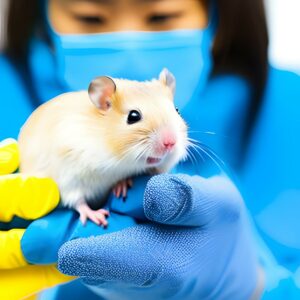They open their eyes at around two weeks of age and become sexually mature at approximately 4 to 6 weeks. Hamsters reach their full size and maturity in around three months.
They may not live long, they become senior rodents quite quickly but this doesn’t mean we can’t love them even more.
In this piece, we are talking about different hamster lifespans and factors that influence longevity, and I share some tips on how to have the best life with your hamster regardless of their age.
Many factors will influence hamster life expectancy, so let’s get to it.
How long do hamsters live?
| Hamster breed | How Long Do Hamsters Live |
| Syrian hamster (Golden or Teddy bear hamster) | 2 – 3 years |
| Robovski dwarf hamster (Robo hamster) | 2 – 4 years |
| Chinese striped hamster | 2 – 3 years |
| Winter white dwarf hamster (Russian dwarf hamster, Djungarian hamster, or Siberian hamster) | 1,5 – 2 years |
| Campbell’s dwarf Russian hamster | 2 – 3 years |
| Grey Dwarf Hamster | 1.5 – 3.5 years |
| Black-bellied, European, or common hamster | 2 – 3 years |
| Gansu Hamster | 2 – 3 years |
| Chinese dwarf hamsters | 2 – 3 years |
On average lifespan in hamsters is 1.5 – 4 years. Individual hamsters can have different life expectancy.
How Long Do Hamsters Live: Table of Contents
How Long Do Syrian Hamsters Live
The average lifespan of Syrian hamsters, also known as golden hamsters, is generally around 2-3 years when kept as pets.
Factors such as genetics, social interaction, and environmental conditions can influence their lifespan. In the wild, Syrian hamsters have a shorter lifespan, typically around 1-2 years. It’s worth noting that individual hamsters may live shorter or longer lives depending on various factors.
How Long Do Robovski Dwarf Hamsters Live
The Roborovski Dwarf hamster, also known as the Robo hamster, has an average lifespan of 2 to 4 years in captivity. In the wild, their lifespan is shorter, usually around 1 to 2 years or less due to predators and harsh environmental conditions
How Long Do Chinese Striped Hamsters Live
Chinese striped hamsters typically live for about 2 to 3 years.
There may be some confusion between Chinese striped hamsters and Chinese dwarf hamsters. While Chinese striped hamsters are sometimes referred to as Chinese dwarf hamsters, they are a distinct species (Cricetulus barabensis) and should not be confused with true dwarf hamster species like Roborovski, Campbell’s, and Winter White hamsters.
How Long Do Winter White Dwarf Hamsters Live
The average lifespan of Winter white dwarf hamsters is around 1.5 to 2 years. However, with proper care, diet, exercise, and an enriched environment, they have the potential to live longer than their average lifespan.
How Long Do Campbell’s Dwarf Russian Hamster Live
Campbell’s dwarf hamsters, also known as Campbell’s Russian hamsters or Phodopus campbelli, have an average lifespan of 2 to 3 years when raised in captivity. In the wild, their lifespan may be shorter.
How Long Do Grey Dwarf Hamsters Live
Grey dwarf hamsters, also known as grey hamsters or migratory hamsters, have an average lifespan of about 1.5 to 3.5 years. Their lifespan can vary depending on factors such as genetics, diet, living conditions, and overall health care.
How Long Do Black-bellied (European/ Common Hamsters) Live
Black-bellied hamsters, also known as European or common hamsters, have an average lifespan of about 2 to 3 years in the wild. In captivity, they can live slightly longer, with a lifespan of up to 3.6 years being recorded for a hamster in captivity.
How Long Do Gansu Hamsters Live
The lifespan of Gansu hamsters can range from two to three years.
It is one of the rarest hamster species in the world and has been classified as endangered due to overhunting, habitat destruction, and climate change
How Long Do Chinese Dwarf Hamsters Live
Chinese dwarf hamsters have an average lifespan of 2 to 3 years.
Although they are called dwarf hamsters, they are not technically dwarf hamsters but are named so due to their smaller size compared to other common pet hamsters like the Syrian hamster.
Hamster life cycle
After a short gestation period, hamsters are born in litters that can range in size from one to as many as twenty babies. Hamster babies are called pups. At birth, hamsters are blind, deaf, and hairless.
Infancy: Newborn hamsters rely on their mother for food and protection. They begin to grow fur at around 10 days old and their eyes open at approximately two weeks of age.
Adolescence: Hamsters enter the adolescence stage around four to six weeks of age. This is when they reach sexual maturity. It is recommended to wait until they are at least 8-12 weeks old or weigh between 90-100 grams before breeding them.
Adulthood: Hamsters reach adulthood after their adolescence stage. They are fully developed physically and sexually mature. Adult hamsters can live independently and are capable of reproducing.
Reproductive Senescence (Start of Old Age): As hamsters age, they may enter the stage of reproductive senescence. This is when they become less fertile and may no longer be capable of successful reproduction. The onset of this stage can vary among individual hamsters.
Senior/Old Age: Hamsters have a relatively short lifespan, and they are considered old after reaching around 12 months of age. The signs of aging may include a decline in activity, decreased appetite, and various age-related health issues. Elderly hamsters require special attention and care.
What is the oldest hamster to live?
The oldest hamster ever was 4.5 years old according to Guinness world record. It was owned by Karen Smeaton of Tyne & Wear, United Kingdom.
But I find comments on the post to be fascinating.

The Syrian hamster breed, also known as the golden hamster, is more likely to live longer than dwarf hamster varieties.
How long do hamsters live in the wild?
The lifespan of hamsters living in the wild can vary depending on the species and environmental factors.
Wild hamsters generally have shorter lifespans compared to their domesticated counterparts.
Here are some key findings:
- The average lifespan of hamsters in the wild is around 1.5 to 3 years.
- Wild hamsters can live longer than pet hamsters under certain conditions. For example, the European hamster (Cricetus cricetus) has a lifespan of up to 8 years in the wild.
- Hamsters in the wild face various challenges and predators that can significantly affect their survival. Factors such as predation, limited resources, and harsh environmental conditions can impact their lifespan.
- Domesticated hamsters, when released into the wild, have a low chance of survival due to their dependency on human care and lack of essential survival skills.
Factors That Affect Hamster Lifespans
Several different factors can impact hamsters’ lifespans.
- Breed
- Genetics
- Diet
- Living conditions
- Health
- Exercise
- Size and Body Composition
Different types of hamsters have different average lifespans. For example, Syrian hamsters typically live between 2 to 3 years, while dwarf hamsters can live anywhere from 1.5 to 3 years.
Genetics
Just like humans, some hamsters may be born with certain genetic predispositions that make them more or less susceptible to certain health conditions. For example, some hamsters may be more prone to developing tumors or other illnesses.
Diet
Hamsters require a good-quality, balanced, and varied diet to ensure they receive all the essential nutrients and minerals they need. A healthy pelleted rodent diet specifically made for hamsters provides the necessary nutrients in the appropriate proportions.
When nutritional needs are not met hamsters will develop health issues and have a shorter life span.
Living conditions
Inadequate living conditions are the main cause of health issues such as bacterial, viral, and fungal infections. Poor living conditions also impact breathing and the respiratory system which leads to high mortality rates in hamsters.
We created a Guide on How to Clean A Hamster Cage.
Health
Different hamster breeds may have varying susceptibilities to specific health issues. For example, certain breeds may be more prone to dental problems, respiratory issues, or genetic disorders.
Exercise
Without sufficient exercise, hamsters can become overweight and even obese. Obesity can lead to various health problems, including diabetes, heart disease, joint issues, and reduced lifespan.
insufficient exercise can even lead to paralysis in hamsters.
Lack of physical activity can result in weakened muscles, loss of coordination, and ultimately, the inability to move properly.
Size and Body Composition
Generally, smaller breeds tend to have shorter lifespans compared to larger breeds.
Tips for Extending Your Hamster’s Lifespan
While there is no magic formula for extending your hamster’s lifespan, there are a few things you can do to help ensure they live a happy, healthy life:
1. Healthy Diet
Hamsters need a healthy, balanced diet that is rich in nutrients to stay healthy. Feed your hamster a diet that includes fresh fruits and vegetables, whole grains, and lean protein sources. Avoid feeding your hamster foods that are high in sugar or salt.
Protein: helps with the growth, maintenance, and repair of body tissues. A healthy hamster diet should contain approximately 15-25% protein.
Carbohydrates: are an important source of energy for hamsters. A balanced diet should include approximately 35-40% carbohydrates.
Fat: t is an essential component of a hamster’s diet, it should be provided in moderation. A healthy hamster diet should contain approximately 4-5% fat.
A teaspoon of chopped nuts, a small piece of sweet potato or carrot, or even half a teaspoon of hard-boiled egg.
Fiber: is important for hamsters’ digestive health. A diet containing around 5% crude fiber is recommended.
Fresh Vegetables and Fruit: hamsters can benefit from small amounts of fresh vegetables and fruit as a supplement to their pelleted diet. However, it’s important to offer these in moderation, as excessive amounts can lead to digestive issues and obesity.
Apple, pear, banana, or even a slice of strawberry. Always remove any seeds or pits from the fruit before offering it to your hamster
Avoid Strict Seed Diets: Hamsters should not be fed a strict seed diet as seeds are high in fat and poor in nutrition. Such diets can lead to obesity and nutrient deficiencies.
Vitamin E: Vitamin E deficiency can lead to muscle paralysis, stiffness, and lameness. Providing a balanced diet and, if necessary, consulting with a veterinarian regarding vitamin E supplementation can help prevent deficiencies.
2. Hydration
Ensure a constant supply of fresh and clean water to keep your hamster hydrated. Replace the water daily and clean the water dispenser regularly to prevent bacterial growth.
3. Exercise and Stimulation
Hamsters are active animals that need plenty of exercise and stimulation to be happy and healthy.
Make sure your hamster’s cage is large enough for them to run around, and provide plenty of toys and other enrichment items to keep them stimulated.
Physical Exercise: Hamster wheels or exercise balls can be excellent additions to their environment, allowing them to engage in physical activity and promote cardiovascular health.
Mental Stimulation: Mentally stimulating toys and activities can prevent boredom and encourage natural behaviors. These may include hiding treats for them to find, offering chew toys, providing tunnels or mazes, or rotating toys to keep their environment interesting.
Enriching Environment: This can be achieved by adding various types of safe and appropriate bedding materials, hiding spots, and objects for climbing and exploring. A diverse and stimulating environment can help prevent stress and promote natural behaviors.
Regular exercise and mental stimulation have l health benefits for hamsters.
Physical exercise helps maintain muscle strength and cardiovascular health, while mental stimulation can prevent boredom-related issues like repetitive behaviors and excessive chewing. These activities can also help in reducing stress levels, preventing obesity, and promoting overall well-being
4. Clean and Safe Living Environment
Clean their cage regularly and provide fresh water and clean bedding. Make sure that their cage is located in a safe place where they are protected from predators and other hazards.
Cage Size: cage sizes range from 2 square feet to 100x50cm allows more exploration, exercise, and natural behaviors.
Cage Type: Solid-based cages are better for hamsters, avoid wire mesh floors that can potentially injure their feet. Wire cages, however, can provide climbing exercise opportunities when supplemented with solid platforms.
Substrate and Bedding: A plant-based substrate should be absorbent, control odors, be non-toxic, and be suitable for burrowing. Recommended options include aspen wood shavings, paper-based substrates, and hay.
Paper bedding options are affordable, soft, and suitable for burrowing. Hamsters can interact with paper bedding comfortably due to their sensitivity to texture
Cleaning: Remove soiled bedding, uneaten food, and clean the cage surfaces. However, ensure not to disturb the hamster’s nest or hiding spots excessively, as they need a sense of security.
If your vet advises you to clean your hamster, please first ask for specific instructions or use our guide: How to clean a Hamster
Ventilation and Temperature: The cage should have proper ventilation to maintain air quality. Avoid placing the cage in direct sunlight or near drafts.
Hamsters are sensitive to temperature extremes, so it’s important to keep the cage in a comfortable environment within their temperature tolerance range.
The ideal temperature range for hamsters is generally between 65 and 75 degrees Fahrenheit (18.5 to 24 degrees Celsius).
Temperatures below 60°F (15°C) may cause hamsters to enter a state referred to as torpor, similar to hibernation, and prolonged cold can lead to dehydration or hypothermia.
On the other hand, high temperatures can cause heatstroke and may be fatal.
5. Socialization
While hamsters are generally solitary animals, they still require social interaction with their human caregivers.
Spend quality time with your hamster by gently handling and playing with them to build trust and strengthen your bond.
6. Stress reduction
Avoid loud noises and sudden temperature changes. To create a calm and stress-free atmosphere play and handle them gently.
7. Regular Health Checkups and Preventative Care
Take your hamster to the veterinarian at least once a year for a checkup, and make sure they receive any necessary vaccines or treatments.
Catching health problems early can help extend your hamster’s lifespan and ensure they live a happy, healthy life.
Our Senior Hamster Care Guide could be of help to better understand the aging process and needs for a healthier and longer hamster life.
How to Determine Your Hamster’s Age
Determining your hamster’s age can give you an idea of how long you can expect them to live.
There are a few ways to estimate your hamster’s age:
Physical Characteristics
Young hamsters have softer, fluffier fur, while older hamsters may have duller, coarser fur.
Older hamsters may also have cloudy eyes or be less active than younger hamsters.
Behavior
Older hamsters are less active and sleep more than younger ones. They may also become less interested in playing or interacting with their toys or other cage mates.
Weight
Generally, younger hamsters are lighter, while older hamsters may have gained more weight over time.
Baby hamsters, also known as pups, at birth, weigh around 2-3 grams. However, their weight can quickly increase as they grow and develop.
The average weight of adult hamsters can vary depending on the breed, sex, and age. In general, hamsters weigh between 0.5 and 8 ounces (21 to 227 grams) on average.
Syrian hamsters can weigh around 4.5 ounces as adults.
Dental Examination
Young hamsters have small, white teeth that have not yet worn down, while older hamsters may have teeth that show signs of wear or overgrowth.
Health Assessment
You may check for any signs of age-related conditions, growths, or abnormalities.
Older hamsters may show signs of aging such as graying fur, bald patches, or visible signs of deterioration.
Vet Q&A
Q: How long do long haired hamsters live?
A: They can live up to 2-3 years.
Q: How long do teddy bear hamsters live?
A: They can live up to 2-3 years.
Q: How old is hamster in 1 year?
A: It is considered that a 1-year-old hamster is 26 years old in human years.
Q: My 2 yo hamster has sores, what can I do?
A: Sores are common skin issues with hamsters. Sores may be caused by bacteria and mites that can agitate hamsters and make them scratch. Inadequate bedding can also cause scratches on the skin. You should have your hamster checked by the vet to avoid complications.
Please read our article Hamster Skin Sores for more detail.
Q: I got a hamster as a gift and I feel sad they live so short. How do I prepare for their death?
A: Unfortunately hamsters do live short lives.
Hamster dying process can last for a couple of weeks or hours. However, the time you have left can still be wonderful. Hopefully, you can follow the above information and provide your hamster with a balanced diet to extend its life. Your vet can also give you more information and advice.
How Long Do Hamsters Live: takeaways
Hamsters are wonderful pets that bring joy and companionship to your life. While their lifespans may be relatively short, there are many things you can do to help ensure that your pet lives as long and healthy of a life as possible.
By providing a healthy diet, plenty of exercise and stimulation, a clean and safe living environment, and regular preventative care, you can help your hamster live the best life possible.
My Senior Paws is a participant in the Amazon Services LLC Associates Program, an affiliate advertising program designed to provide a means for sites to earn advertising fees by advertising and linking to Amazon.com. We also participate in other affiliate programs which compensate us for referring traffic.




